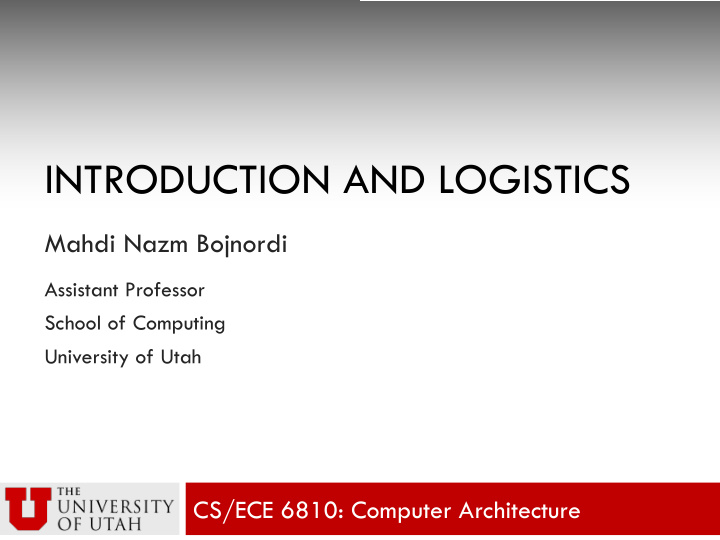



INTRODUCTION AND LOGISTICS Mahdi Nazm Bojnordi Assistant Professor School of Computing University of Utah CS/ECE 6810: Computer Architecture
Overview ¨ This lecture ¤ Instructor ¤ Teaching assistants ¤ Course resources and requirements ¤ Academic integrity ¤ Computer architecture ¤ Trends and challenges
Instructor ¨ Mahdi Nazm Bojnordi ¤ Assistant Professor of School of Computing ¤ PhD degree in Electrical Engineering ¤ Personal webpage: http://www.cs.utah.edu/~bojnordi/ ¨ Research in Computer Architecture ¤ Novel Memory Technologies ¤ Energy-Efficient Hardware Accelerators ¤ Research Lab. (MEB 3383) n Open positions are available for motivated students! ¨ Office Hours (MEB 3418) ¤ Wed. 3:00-5:00PM ¨ Class webpage: http://www.cs.utah.edu/~bojnordi/classes/6810/f19/
Webpage ¨ Please visit online
Teaching Assistants ¨ Payman Behnam ¤ Email: paymanbehnam@gmail.com ¤ Office Hours: Mon. 12:00-2:00PM ¤ MEB 3115 (TA Lab.) ¨ Venkatrajreddy Sunkari ¤ Email: venkatrajreddy.sunkari@utah.edu ¤ Office Hours: Tue. 3:00-5:00PM ¤ MEB 3115 (TA Lab.)
Resources and Requirements ¨ Textbook: Computer Architecture A Quantitative Approach - 5th Edition, John Hennessy and David Patterson ¨ Pre-requisite: CS/ECE 3810 or equivalent
Course Expectation ¨ We use Canvas for homework submissions, grades, and homework announcements. ¨ Grading Fraction Notes Assignments 30% homework assignments Midterm Exam 30% Monday, October 15th Final Exam 40% Thursday, December 13th Class Participation --% Questions and answers in class
Homework Assignments ¨ Homework assignments will be released on Canvas; all submissions must be made through Canvas. ¨ Only those submissions made before midnight will be accepted. ¤ Important: Please verify your uploaded file before midnight. ¨ Any late submission will be considered as no submission. Release Date Submission Deadline Homework 1 August 28th September 4th Homework 2 September 11th September 18th Homework 3 September 25th October 2nd Homework 4 October 30th November 6th Homework 5 November 13th November 20th
Academic Integrity ¨ Do NOT cheat!! ¤ Please read the Policy Statement on Academic Misconduct, carefully. ¤ We have no tolerance for cheating ¨ Also, read to the College of Engineering Guidelines for disabilities, add, drop, appeals, etc. ¨ For more information, please refer to the important policies on the class webpage.
Why CS/ECE 6810? ¨ Need another qualifier/graduation requirement? ¨ You plan to become a Computer Architect? ¨ Understand what is inside a modern processor? ¨ Want to use the knowledge from this course in your own field of study? ¨ Understand the technology trends and recent developments for future computing? ¨ …
Why CS/ECE 6810? ¨ Better understanding of today’s computing problems ¤ Security flaw: Spectre and Meltdown ¤ How to fix?
Estimated Class Schedule ¨ Processor Core ¤ Introduction and Performance Metrics ¤ Instruction Set Architecture and Pipelining ¤ Instruction-Level Parallelism ¤ Compiler Optimization ¤ Dynamic Instruction Scheduling ¨ Memory System ¤ Cache Architecture ¤ Virtual Memory ¤ Main Memory and DRAM ¤ Data Parallel Processors
What is Computer Architecture? ¨ Computer systems are everywhere …
What is Computer Architecture? ¨ What is inside modern processors … ? VLSI Circuits Software Applications Hardware Implementation OS and Compiler
What is Computer Architecture? ¨ Computer architecture is the glue between software and VLSI implementation ISA, μ architecture , system Architecture VLSI Circuits Software Applications Hardware Implementation OS and Compiler
What is Computer Architecture? ¨ Architects ¨ Computer Architects Computer Architects
Growth in Processor Performance Source: Hennesy & Patterson Textbook
Growth in Processor Performance ¨ Main sources of the performance improvement ¤ Enhanced underlying technology (semiconductor) n Faster and smaller transistors (Moore’s Law) ¤ Improvements in computer architecture n How to better utilize the additional resources to gain more power savings, functionalities, and processing speed.
Moore’s Law ¨ Moore’s Law (1965) ¤ Transistor count doubles every year ¨ Moore’s Law (1975) ¤ Transistor count doubles every two years Source: G.E. Moore, "Cramming more components onto integrated circuits," 1965
Why study computer architecture? ¨ Do the conventional computers last forever? ¤ New challenges ¤ New forms of computing
What are New Challenges? ¨ Resources (transistors) on a processor chip? ¤ Not really, billions of transistors on a single chip. ¨ Can we use all of the transistors? ¤ Due to energy-efficiency limitations, only a fraction of the transistor can be turned on at the same time! ¨ Who is affected? ¤ Server computers by the peak power ¤ Mobile and wearables due to energy-efficiency
What are New Challenges? ¨ Bandwidth optimization becomes a primary goal for memory design (Bandwidth Wall!)
What are New Challenges? ¨ Can in-package memory solve the problem? Off-chip Memory 3D Stacked Memory Lower Bandwidth Higher Bandwidth Lower Costs Higher Costs
What are New Challenges? ¨ Protecting data against side channel attacks is a serious need ¨ Performance in the past 40 years increased ¤ hardware speculation to exploit more instruction level parallelism ¤ shared memories to facilitate thread-level parallelism ¨ What about security? ¤ https://meltdownattack.com/
Unconventional Computing Systems ¨ How to program a Quantum computer? ¤ Qbit vs. bit
Emerging Non-volatile Memories ¨ Use resistive states to represent data ¤ Can we build non-von Neumann machines? n In-Memory and In-situ computers
Recommend
More recommend